The LIUniverse with Dr. Charles Liu
A half-hour dose of cosmic conversation with scientists, educators and students about the cosmos, scientific frontiers, scifi, comics, and more. Hosted by Dr. Charles Liu, PhD, an astrophysicist at the American Museum of Natural History. Support us on Patreon.
Episodes
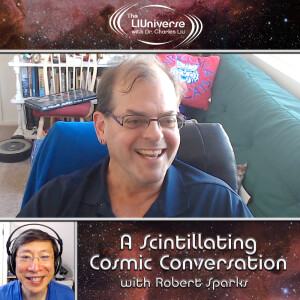
Saturday Jan 25, 2025
Saturday Jan 25, 2025
Have you ever wondered how data from the telescopes that peer into our universe ends up in the hands of the astronomers who interpret it? To find out, Dr. Charles Liu and co-host Allen Liu welcome Robert Sparks, currently from the NSF’s NOIRLab, but previously Fermi Lab and the Sloan Sky Survey.
The National Optical InfraRed Astronomy Research Lab is responsible for operating the National Science Foundation’s ground based, nighttime optical and near infrared astronomy for the United States. Robert describes their Community Science Data Center which ties all the data from all their telescopes together to make it available for astronomers around the world to use in their research.
As always, though, we start off with the day’s joyfully cool cosmic thing, a project coming out of NOIRLab called 88 Constellations. Robert, who spearheaded the project, explains how the final, incredibly detailed image combined classic constellations and new, modern additions and covered the entire sky. One of his favorite parts of the project? Learning about the constellations in the southern hemisphere that doesn’t get to see that often, like the Southern Cross. Chuck, Allen and Robert share some of their experiences stargazing down below, and yes, you know Chuck takes the opportunity to sing us a little Crosby, Stills and Nash! You’ll also hear which constellation is the smallest in the southern hemisphere, Crux (the Southern Cross) or Delphinus.
Then it’s on to audience questions. Our first comes from Amirah, who asks, “Blue stars are hotter than red stars, so does that mean blue light bulbs are hotter than red light bulbs? Why would something's color matter about how hot something is?” The short answer: yes (pre-LED, that is!) Robert’s long answer involves black body radiation, the electromagnetic spectrum, and red giant carbon stars.
Rob shares stories from a career that bridges astronomy and particle physics, including how he got his hands on some original scintillator material from particle detectors at Fermi Lab. (Check out The LIUniverse on Patreon for a scintillating deep dive into…well, scintillation!)
The next audience question, from Bryan, is particularly relevant to the discussion: How do astronomy and physics work together? In many, ways, as Robert and Chuck explain. Allen shares the story of the discovery of the element Helium, which was first discovered in the Sun by astronomers, hence its name.
You’ll also get to hear about Robert’s 38-year-long career in improv comedy – and get to watch him (and his cat) act out scenes prompted by Chuck.
Finally, we’ve got one last audience question from Jerry, who says, “I live really far away from the city and I don't have a telescope. What's the best way for me to do astronomy research?” Robert, who grew up in Iowa, tells Jerry about citizen science astronomy projects he can get involved like those at The Zooniverse. You’ll hear about how, while working at a program there known as the Galaxy Zoo, a Dutch schoolteacher named Hanny Van Arkel discovered a weird light echo from a quasar that is now known as “Hanny’s Voorwep” (Hanny’s Object).
If you’d like to find out more about NOIRLab, the National Optical InfraRed Astronomy Research Lab, check out their website.
To keep up with Robert Sparks, you can follow him @halfastro on Bluesky, Threads, Flikr, and Instagram.
We hope you enjoy this episode of The LIUniverse, and, if you do, please support us on Patreon.
Credits for Images Used in this Episode:
Mauna Kea observatories in Hawaii – Credit: Wikicommons/Alan L.
Kitt Peak National Observatory (KPNO) in Arizona. – Credit: KPNO/NOIRLab/NSF/AURA/T. Slovinský
3-D view of the largest structures in the Universe via data from the Sloan Digital Sky Survey. – Credit: NASA/University of Chicago and Adler Planetarium and Astronomy Museum
88 Constellation sky-scape video compiled using images from the best and darkest locations around the globe: Germany (Waldenburg), Spain (Tenerife, La Palma), Namibia and Chile. – Credit: NOIRLab/NSF/AURA/E. Slawik/M. Zamani
The constellation Crux (Southern Cross) – Credit: E. Slawik/NOIRLab/NSF/AURA/M. Zamani
The constellation Delphinus – Credit: E. Slawik/NOIRLab/NSF/AURA/M. Zamani
Illustration of the spectrum of electromagnetic energy, highlighting the portions detected by NASA’s Hubble, Spitzer, and Webb space telescopes – Credit NASA
Event captured by the Super Kamiokande detector – Credit: Tomasz Barszczak/Super-Kamiokande collaboration
Visualization of two colliding galaxies that merge into a single elliptical galaxy over a period spanning two billion years – Credits: NCSA, NASA, B. Robertson, L. Hernquist
Helium spectral lines which appear in the visible spectrum at about 400-700 nanometers. – Credit: Creative Commons/ McZusatz
Hanny’s Voorwep, A Space Oddity – Credit: NASA, ESA, W. Keel (University of Alabama), and the Galaxy Zoo Team
#TheLIUniverse #CharlesLiu #AllenLiu #SciencePodcast #AstronomyPodcast #NOIRLab #NSF #FermiLab #SloanDigitalSkySurvey #88Constellations #GalaxyZoo #TheZooniverse #blackbodyradiation #electromagneticspectrum #redgiants #carbonstars #particlephysics #scintillatormaterial #particledetectors #scintillation #HannysVoorwep
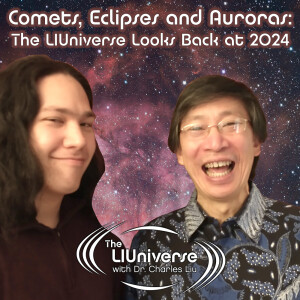
Saturday Jan 04, 2025
Saturday Jan 04, 2025
What were the coolest science and sci-fi events in the LIUniverse in 2024, and what’s in store for us in 2025? To find out, Dr. Charles Liu and co-host Allen Liu welcome three members of our production team: Leslie Mullen, our Executive Producer making her first on air appearance, Jon Barnes, our Editor, and Stacey Severn, our Social Media/Patreon Community Director, both of whom are familiar to longtime fans.
But first, as always, we start with the day’s joyfully cool cosmic thing: the latest development in the dispute that astrophysicists call the “Hubble Tension.” Over the past 20 years, the two different methods of measuring the Hubble Constant, which is used to calculate the rate of universal expansion, have led to two different conclusions. Leslie points out that the universe isn’t confused, we are, leading to a conversation about why accurate measurements matter in helping us expand our limited understanding.
Then we begin our look back at the year in astronomy – or rather, our look up. Stacey takes us on a tour, from a Geminid meteor hitting the moon, to the spectacular aurora borealis visible in the Northeastern US, to Comet C/2023 A3 Tsuchinshan-ATLAS, to, of course, the Great North American Eclipse. The team share their viewing experiences while Chuck explains the impact of solar max on both the eclipse and the auroras.
Next, Jon Barnes is back to talk about “The Three-Body Problem” science fiction series on Netflix. He asks Chuck to explain what we really know about cosmic particles (aka cosmic rays), because, in the series, the aliens use sophons, a supercomputer combined with a photon, to communicate across long distances at or near the speed of light. You’ll also hear about the recent detection of a surprisingly large number of very high energy cosmic rays that are hitting us right now.
Our fan question comes from Pshemo on Patreon and concerns an experiment to measure the dynamics of a local system relative to spacetime by using light as a way of gauging the background nature of the universe. And if you think that sounds pretty geeky, it’s nothing compared to the conversation between Allen, Chuck and Leslie that ensues, encompassing Einstein, the Michelson–Morley experiment, gravitational waves, LIGO, Virgo, KAGRA, and LISA.
There’s plenty more in this episode, including a discussion of the recent wave of drone sightings, their similarity to the past UFO sightings, and the likelihood that they are all explained by less exotic causes than aliens. Moving on to the coolest “identified flying objects” of 2024, Leslie tells us about the Europa Clipper, which launched in October. It will reach orbit around Jupiter in 6 years in order to search for alien life in the subsurface oceans of its icy moon Europa. Chuck reminds us all that NASA’s Parker Solar Probe will make its closest approach to our Sun on Christmas Eve 2024.
Finally, it’s time for the team to share what they’re looking forward to in 2025. Jon is psyched for “Mickey 17,” a film by director Bong Joon-ho about a clone on a space colony. Allen is excited for Rocket Lab’s Venus Life Finder, the first private interplanetary space probe, which launches in January to search for organic compounds within Venus' atmosphere. Stacey is looking forward to Axiom Space’s fourth mission to the ISS in 2025, an international trip to conduct scientific experiments commanded again by Peggy Whitson. Leslie is most excited for the discovery nobody is expecting, whatever that may be.
And what is Chuck looking forward to most in 2025? The long-awaited start of scientific operations at the Vera Rubin Observatory, which will take a full picture of the sky every 30 seconds for ten years and deliver an unprecedented level of data for astronomers to feast upon!
We hope you enjoy this episode of The LIUniverse, and, if you do, please support us on Patreon.
Credits for Images Used in this Episode:
Illustration of the Hubble constant – NASA/ESA/StSci, Public Domain
Gianluca Lombardi Geminid meteor shower video podcast – ESO, Public Domain
Northern Lights over the Northeastern US in 2024. – Elliot Severn, All Rights Reserved
Northern Lights over the Northeastern US in 2024. – Allen Liu, All Rights Reserved
Comet C/2023 A3 Tsuchinshan-ATLAS – Elliot Severn, All Rights Reserved
Map showing total solar eclipse viewing in US in 2017 and 2024. – Ernest Wright/NASA’s Scientific Visualization Studio, Public Domain
Total solar eclipse, April 8, 2024. – Elliot Severn, All Rights Reserved
How LIGO achieves steadiness – Caltech/MIT/LIGO Lab, Public Domain
Europa Clipper construction – NASA/JPL, Public Domain
Artist rendering of Europa Clipper traveling to Jupiter – NASA/JPL, Public Domain
Artist concept of the Casini spacecraft flying through the water/ice plumes of Enceladus – NASA/JPL, Public Domain
Artist concept of NASA’s Parker Solar Probe flying close to the Sun. – NASA, Public Domain
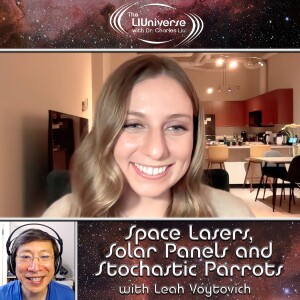
Sunday Dec 22, 2024
Sunday Dec 22, 2024
How far can following your passions take you in science? To find out, Dr. Charles Liu and co-host Allen Liu welcome the multi-faceted Leah Voytovich, a software development engineer for Project Kuiper who planned on going to med school but instead ended up working on space lasers for Amazon’s satellite internet constellation.
As always, though, we start off with the day’s joyfully cool cosmic thing: the use of deuterium levels in the search for exoplanets with advanced civilizations. That’s because signs of deuterium depletion can indicate that a planet has developed nuclear fission power.
After that, Leah tells us a little about Amazon’s Project Kuiper. She explains the wide variety of challenges to keeping the satellites, which are in low earth orbit, in communication with the ground. The project she’s working on now is using infrared space lasers to communicate more securely within the satellite constellation.
Chuck brings up the impact that these massive groups of satellites like Starlink are having on astronomy, from satellite streaks on dark sky surveys to image-destroying flares. Leah said there are people working on reducing Project Kuiper’s impacts across multiple areas of concern.
For our first question. Yasmin asks, “Will our satellites all be controlled by AI someday? If so, when? And is this a good idea?”
Leah speculates that there may be some projects already using Machine Learning here on Earth, but that it will be further down the line before there’s AI actually present in satellites themselves. Leah doesn’t see a problem with the use of ML tools for science, as long as there are protections in place and that humans are still writing the software.
After our break, Leah tells us about what she does outside her work – literally – from climbing Mount St. Helens in winter using an ice ax and crampons, to skiing, to running marathons – 3 so far!
Then we’re back to AI, ML, and the differences between the two. Charles talks about how important AI has beome as a tool for astronomers and other scientists. Leah explains the “Chinese Room Argument” and why it’s a good analogy for machine learning, Allen shares the description of AI as a “stochastic parrot.”
Our next question comes from Jonathan, who asks, “With so many problems facing the world like poverty, war and the climate crisis here on Earth, why should we spend money and resources on space exploration and astronomy?”
Leah talks about how Project Kuiper is intended to serve underserved communities by providing internet access to people who don’t already have it. That in turn increases global communication and connectivity and can then help address those other problems. And of course, to launch those satellites, we need rockets.
She also explains how valuable internet access is to communities– something she knows a little about. She and Martin Leet co-founded Maji, a nonprofit in Uganda that uses solar power to make clean water easily accessible for refugee communities. Leah, a former EMT, explains how Maji also provides first aide medical training and agricultural training to the communities. The story of how Maji came to be is remarkable – we’ll leave it to Leah to share that with you in the episode.
We end with Leah recounting what it was like to be in Mission Control for the launch of the first Project Kuiper satellites. She was the representative for her team in the Mission Control room, so she was the one who actually got to say “Go” for her service during the final pre-launch Go/No Go review.
If you’d like to know more about Maji, you can check out the nonprofit’s website here.
We hope you enjoy this episode of The LIUniverse, and, if you do, please support us on Patreon.
Credits for Images Used in this Episode:
Illustration of Kepler-138 exoplanets– NASA, ESA, Leah Hustak (STScI)
Deuterium, aka hydrogen-2 (²H or D) – Center for Deuterium Depletion
An axonometric view displays various Earth orbits, illustrating space debris and active satellites – WikiCommons/Pablo Carlos Budassi
The history of the universe since the Big Bang – NASA
Satellite streaks in an astronomical image – University of Washington/ Abhilash Biswas, Kilando Chambers, and Ashley Santos
Space-based lasers – IEEE Spectrum
Illustration of NASA’s Laser Communications Relay Demonstration (LCRD) communicating with the I.S.S. over laser links – NASA’s Goddard Space Flight Center
Illustration of machine learning and artificial intelligence – Creative Commons / mikemacmarketing
Computer simulation of dendrites of pyramidal neurons – Hermann Cuntz/ PLoS Computational Biology, Vol. 6(8) August 2010.
Earth illuminated time-lapse video if ISS over Earth – NASA
Martin Leet and Leah Voytovich – University of Pennsylvania
The Maji water tank for the Olua I community – University of Pennsylvania/Martin Leet
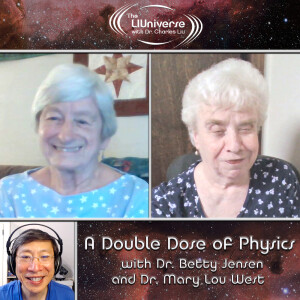
Saturday Dec 07, 2024
Saturday Dec 07, 2024
What was it like forging a career in physics as a woman in the 1970s? To find out, Dr. Charles Liu and co-host Allen Liu welcome the “Dynamic Duo of Physics” – physicist Dr. Betty Jensen and astrophysicist Dr. Mary Lou West.
As always, though, we start off with the day’s joyfully cool cosmic thing, a potential new revelation about Jupiter’s Great Red Spot. It seems that the current spot may be only 190 years old rather than 400 years old, and that the first spot described by Cassini in the 1600s may have actually disappeared in the early 1700s. Mary Lou points out that the older spot may not even have been red and gives us a primer on the storms of Jupiter.
Next, Betty talks about her love of math and science, her research in fusion energy, and how she forged her own path to becoming the physicist she always knew she would be. Both scientists talk about how “the two body problem” led each of them to stay in the New York area. Mary Lou talks about how she also studied math and physics, but how she ended up becoming an astrophysicist.
Then it’s time for an audience question for Dr. Jensen and Dr. West: “What kinds of mentoring opportunities were available during your PhD years?” Betty says that while as the lone woman in her area she didn’t feel very supported, she did have some really good experiences with professors at Columbia University, including Nobel prize winner in physics Dr. Isadore Isaac Rabi.
Mary Lou, who was also at Columbia, tells the story of how she had to do a second thesis after someone published on the subject she’d been working on. She also recounts the wild story of how she used a children’s chalkboard to save her PhD thesis defense after student protests disrupted it.
Charles brings up the story of Dr. Chien-Shiung Wu, one of the most famous woman physics professors of the period and a member of the Manhattan Project, with whom Betty took a class. In a perhaps unsurprising turn of events, Dr. Wu and the other women on her team who conducted the “Wu Experiment” were ignored by the Nobel Prize committee in favor of the male scientists who predicted the results of her experiment.
Throughout the episode, Betty and Mary Lou share some of their most interesting experiences, from riding in the back of a car with Edward Teller, the father of the H-Bomb, to the nearly catastrophic installation of a large telescope at the Harriman Observatory.
Chuck talks with Betty and Mary Lou about what it was like to use computers in the punch card era. It turns out, both Betty’s dissertation and Mary Lou’s thesis were on punch cards!
Finally, after the two scientists brag about their families, Chuck asks them for some parting words of advice for future scientists. But we wouldn’t dream of speaking for them, so please tune in to the episode for words of wisdom from these two inspirational physicists.
We hope you enjoy this episode of The LIUniverse, and, if you do, please support us on Patreon.
Credits for Images Used in this Episode:
Great Red Spot seen by the Juno probe – Kevin Gill, CC BY 2.0
Cassini’s drawing of Jupiter’s “permanent spot” – Giovanni Domenico Cassini, Public Domain
Great Red Spot in the 1880s – Thomas Gwyn Elger
Magnetic plasma storms on the Sun – Courtesy of NASA/SDO and the AIA, EVE, and HMI science teams, Public Domain
Dr. Isadore Isaac Rabi – Nobel Foundation
Dr. Chien-Shiung Wu at work – Smithsonian Institution, no known copyright restrictions
Dr. Edward Teller – UC Davis, CC BY 2.0
#TheLIUniverse #CharlesLiu #AllenLiu #SciencePodcast #AstronomyPodcast #Physics #Astrophysics #BettyJensen #MaryLouWest #Jupiter #GreatRedSpot #MagneticPlasmaStorms #JovianStorms #SolarStorms #Cassini #NobelPrize #IsadoreIsaacRabi #ChienShiungWu #EdwardTeller #ManhattanProject #HarrimanObservatory #ColumbiaUniversity #TwoBodyProblem
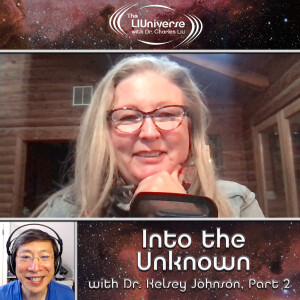
Saturday Nov 23, 2024
Saturday Nov 23, 2024
Why should people care about fundamental questions of existence or try to understand the principles of our universe? Because we may be the only sentient beings in existence who can! At least, that’s what returning guest Dr. Kelsey Johnson, past president of the AAS and the ASP, and author of “Into the Unknown – The Quest to Understand the Mysteries of the Cosmos, tells Dr. Charles Liu and co-host Allen Liu as our interview resumes.
And then we’re off and running! Kelsey explains where her passion for astrophysics comes from, and why it’s our responsibility to explore the reality in which we live. You’ll hear about how really big our universe is and why we need to get comfortable with the unknown – with an assist from Rainer Maria Rilke’s “Letters To A Young Poet.”
Our first question comes from Violetta, who asks, “What was the most interesting thing that got you into astrophysics?” Kelsey describes how, long before she knew anything about astronomy, she fell in love with Vega while staring at it from the middle of a giant potato field. She talks about what it’s like to discover something through a telescope that no one on Earth has ever seen before. Charles shares a memory about hunting for – and discovering – quasars around the Hubble Deep Field (North) when he was a post-doc using the MMT Telescope in Arizona. Kelsey talks about seeing the unbelievable night sky while visiting the site of the ALMA Observatory in the Atacama Desert in Chile.
We end the episode with Chuck and Kelsey talking about how hard it can be for parents to get their kids to follow in their footsteps, at least when those footsteps lead to a telescope!
If you’d like to know more about Kelsey, you can visit her website and follow her on Twitter (X) and Instagram at @ProfKelsey,
We hope you enjoy this episode of The LIUniverse, and, if you do, please support us on Patreon.
Credits for Images Used in this Episode:
The Hubble Deep Field (north) – NASA, Public Domain
Inside the MMT observatory – Bill85704 on Flickr, CC BY 2.0
Two of ALMA’s radio antennae – Iztok Bončina/ESO, CC BY 4.0
Vega – Stephen Rahn, public domain (CC0)
#TheLIUniverse #CharlesLiu #AllenLiu #SciencePodcast #AstronomyPodcast #KelseyJohnson #AAS #ASP #IntotheUnknown #RainerMariaRilke #LettersToAYoungPoet #ALMAObservatory #AtacamaDesert #Vega #MMTObservatory #HubbleDeepField
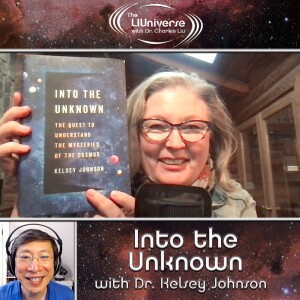
Saturday Nov 09, 2024
Saturday Nov 09, 2024
Why is star formation the workhorse of the universe? What is a flocculent galaxy? Which cosmic cataclysm creates new globular star clusters? And why are we currently seeing such amazing aurora in unusual places?
To find out, Dr. Charles Liu and co-host Allen Liu welcome astronomer Dr. Kelsey Johnson, past president of the American Astronomical Society (AAS) and of the Astronomical Society of the Pacific (ASP), and author of “Into the Unknown – The Quest to Understand the Mysteries of the Cosmos.”
As always, though, we start off with the day’s joyfully cool cosmic thing, the auroras that have been occurring during the peak of the current solar max period of the roughly 11-year-long solar cycle. From the Mother’s Day aurora borealis in May to the amazing night of October 10, when millions of people as far south as Florida and Mexico were treated to one of the most spectacular, vibrant light shows many of them had ever seen.
Kelsey shares the story of the first time she saw an aurora, as a high school student in Minnesota who didn’t even know what one was. Upon leaving her boyfriend’s house at around 2 in the morning, she saw a brilliantly glowing sky. Kelsey’s availability bias kicked in, and her assumption was that it had to be either god or aliens, with the latter being the more likely. Needless to say, the next day the front page of the local paper solved the mystery.
And then it’s on to a nerdy discussion of existential curiosity, deep, philosophical questions, and her book, “Into the Unknown.” You’ll hear what drove Kelsey to write the book, and about her lifelong drive to understand our place in the universe. Kelsey and Allen nerd out over Calabi-Yau manifolds (concepts from string theory), imaginary numbers and complex numbers, Euler’s Formula and more, and then, thankfully, it’s time for our first question.
Johnny asks, “What is a flocculent galaxy, and why are they interesting?” Kelsey says that they’re spiral galaxies with spiral arms that aren’t very pronounced, that are exceptionally “floofy and chaotic” with very different, but very cool star formation. Chuck and Kelsey explain why star formation is the workhorse of the universe and how important it is. Kelsey also explains why globular clusters are her “favorite” type of star cluster. There are about 150 of them living around our galaxy, and they’re almost as old as the universe itself, over 10 billion years old. Kesley studies them to learn how the universe was formed and how galaxies came together. New globular clusters are rare, but they can be created by the collision of two galaxies.
That’s all we could squeeze into Part 1, but come back in two weeks for Part 2 of "Into the Unknown with Dr. Kelsey Johnson."
If you’d like to know more about Kelsey, you can visit her website at and follow her on Twitter (X) and Instagram at @ProfKelsey,
We hope you enjoy this episode of The LIUniverse, and, if you do, please support us on Patreon.
Credits for Images Used in this Episode:
Graph of the solar cycle – David Hathaway, NASA, Marshall Space Flight Center, Public Domain
May 2024 aurora in Northern Ireland – David Kernan, CC BY
May 2024 Aurora from Chihuahua, Mexico – Levi bernardo, CC BY
Chuck & Allen’s view of the October 2024 aurora – Allen Liu
Eugenio Calabi and Shing-Tung Yau – National Science Foundation, Public Domain
Eugenio Calabi and Shing-Tung Yau – Konrad Jacobs
3D model of a Möbius Strip – Inductiveload, Public Domain
3D model of a Klein bottle – Lukáš Hozda, Public Domain
Number line – Rumil, Public Domain
Complex Plane – Brigban, Public Domain
NGC 2775, a flocculent galaxy – European Space Agency, CC BY
Messier 2, a globular cluster – NASA Hubble, CC BY
#TheLIUniverse #CharlesLiu #AllenLiu #SciencePodcast #AstronomyPodcast #KelseyJohnson #AAS #ASP #IntotheUnknown #aurora #solarmax #CalabiYaumanifolds #stringtheory #imaginarynumbers #complexnumbers #flocculentgalaxy #spiralgalaxy #globularclusters #starformation #starcluster

Saturday Oct 26, 2024
Saturday Oct 26, 2024
Happy Halloween! In this special episode of The LIUniverse, Dr. Charles Liu and co-host Allen Liu welcome back archaeology expert Hannah Liu, MEd to bring a scientific eye to the holiday and some of its most familiar denizens: witches, werewolves, zombies, black cats and even the Great Galactic Ghoul!
As always, though, we start off with the day’s joyfully cool cosmic thing: Comet C/2023 A3 (Tsuchinshan-ATLAS). You’ll learn all about this visitor from the Oort Cloud, including how we know where it came from. Hannah talks about how ancient people responded to the arrival of a comet, including how leaders have used them for their own political purposes, and Charles brings up the inclusion of Halley’s Comet on the Bayeux tapestry.
Then it’s time for Chuck to introduce our theme for this special episode: how the superstitions of the past interact with the mysteries of science.
You’ll hear from Hannah about the history of Halloween and its beginning as the Druidic celebration of Sawen (or Samhain) marking the end of the harvest season.
Jumping ahead in history, we look at the Salem Witch Trials of the 17th Century, and the “science” that was used to condemn innocent young women to death for behaviors the powers that be disapproved of.
You’ll also get serious answers to spooky questions like “Do full moons affect behavior?” (We’re talking the behavior of moths, sea turtles and humans, rather than werewolves, although we do actually get into the possible origins of the wolfman myth as embodied in the Greek myth of Zeus and Lycaon with a minor digression into D&D and legendary DJ Wolfman Jack.)
After witches and werewolves, what else could we talk about next than zombies? In this case, natural zombie spiders created by the sting of a parasitic Tarantula Hawk wasp, or zombie ants that have been infected by the fungus Ophiocordyceps unilateralis. And yes, somehow The Walking Dead and The Last of Us shamble into the discussion, although regarding the latter, Allen explains why cordyceps probably couldn’t survive in a human host.
Next up, we look at the connection between black cats and the holiday. Hannah brings up the traditions of cats as “Witch’s Familiars” and shapeshifters, and Chuck reminds us of the moment when we saw a cat transform into Professor McGonagall in Harry Potter and the Sorcerer’s Stone. You’ll hear about how STS-13, which was slated to be the thirteenth mission of the Space Shuttle, was renamed STS-41-C, in an attempt to avoid any superstition or reminder of the ill-fated Apollo 13. There was an alternate mission patch that featured an illustration of the shuttle landing under a giant black cat, referencing the mission's original designation, STS-13; and that the day the mission returned was April 13, 1984, which was a Friday the 13th.
Speaking of space, Hannah asks Chuck about the concept of “The Great Galactic Ghoul,” the fictitious space monster blamed for the failure of nearly every probe sent to Mars by the Soviet Union, Japan, and even NASA between 1988 and 1999. Out of 10 missions, only 2 US probes landed successfully on the Red Planet. Since then, while the Ghoul did claim a few more victims including two missions by the UK, it seems to have gone into hiding, since the US has had multiple successful missions, as has China with their Tianwen lander and Zhurong rover, India, Russia, the European Space Agency, and the UAE.
Finally, to end our special HaLIUween episode, Chuck brings up Albert Einstein’s term, “Spooky Action at a Distance,” which he coined derisively to describe the physics concept known as quantum entanglement that he dismissed but has since been proven to exist.
We hope you enjoyed this special episode of The LIUniverse, and, if you do, please support us on Patreon.
Credits for Images Used in this Episode:
Comet Tsuchinshan-Atlas – AlexL1024, Public Domain
Diagram of the Oort Cloud – NASA, Public Domain
Halley's Comet on the Bayeux tapestry – 11th century English embroiderers, Public Domain
Irish hero Fionn fighting Aillen on Samhain – Beatrice Elvery, Public Domain
Later depiction of the Salem Witch Trials – Joseph E, Public Domain
Painting of the Aos Sí – John Duncan, Public Domain
Ant infected with Ophiocordyceps unilateralis – Denis Zabin
Tarantula Hawk wasp – Davehood, Public Domain
STS-13 alternate mission patch – Bp1222
Mars Climate Orbiter, unit error victim – NASA/JPL, Public Domain
Purported face on Mars – Viking 1, NASA, Public Domain
Better image of the same feature – NASA / JPL / Malin Space Science Systems, Public Domain
China’s Tianwen lander and Zhurong rover – China News Service
#TheLIUniverse #CharlesLiu #AllenLiu #HannahLiu #SciencePodcast #AstronomyPodcast #Halloween #Samhain #Sawen #witches #werewolves #zombies #blackcats #GreatGalacticGhoul #SalemWitchTrials #Ophiocordycepsunilateralis #zombieantfungus #TarantulaHawkwasp #STS13 #CometC2023A3 #CometTsuchinshanAtlas #HalleysComet #BayeuxTapestry
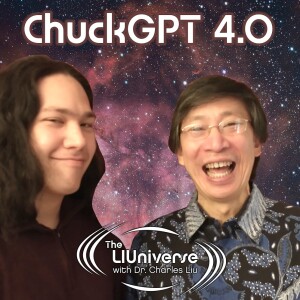
Saturday Oct 19, 2024
Saturday Oct 19, 2024
Welcome to Season 4 of The LIUniverse and thank you for joining us on this journey.
We’re kicking off the new season with another Chuck GPT episode devoted to answering your questions, and to do that, we’ve brought back archaeology expert Hannah Liu, MEd. She’s not alone: joining Dr. Charles Liu and co-host Allen Liu is The LIUniverse’s Social Media Guru, Stacey Severn.
As always, we start off with the day’s joyfully cool cosmic thing, Earth’s temporary second moon 2024 PT5. Don’t get excited, though, because it’s only the size of a school bus and won’t be visible to the naked eye. But it gives Chuck the chance to ask Hannah about the impact of celestial visitors in the past, and she tells us the story of Caesar’s comet (C/-43 K1) which showed up for about a week in the summer of 44 BCE – not long after the assassination of Julius Caesar. Allen also brings up the Great comet of 1680 and how it affected the development of astronomy.
Our first question comes from NSimplexPachinko, who asks, “During condensation of matter to 300,000 years after the Big Bang, did spacetime cease to expand, or did it continue expanding at the same rate as the energy within it?”
Short answer: Yes. For the long answer, you’ll have to watch or listen to the show for Chuck’s description (honed for the Intro to Astronomy class he teaches) of decoupling, expansion, universal evolution and “BIG, BIG, INFLATION!”
Stacey reads the next question from a listener in Poland. Pshemo Ziembora wonders, “The volume/length of space should be different for every observer depending on how fast they’re travelling or how strong the gravity field is. In other words, the speed of light will always be constant for each observer, but it may have a different value than 300,000 km/second. Distances on cosmic scales may vary due to your speed. When you are traveling faster in space your distance should be shorter. What am I missing?”
Chuck explains that Pshemo isn’t missing anything and has got it exactly right, describing the insight we now call the “Lorentz Contraction” which Albert Einstein built into his Special Theory of Relativity. Allen explains the physics involved, with an example that includes muons and cosmic rays and how different mediums can impact the speed of light.
Speaking of Poland, Hannah shares a story about licking the wall of the Wieliczka salt mine, which she visited on a trip there. For those of you watching, you can see a photo of one of the caverns hollowed out by the miners, with statues and scenic reliefs carved from the salt. There are no photos of the reported salt tasting.
Our next question comes from one of Chuck’s Astronomy 100 students: “Is Earth Intelligent?”
Chuck describes the Gaia Hypothesis, before the group grapples with the question. Hannah looks at the skepticism around the validity of that very hypothesis, and then takes a typical LIUniverse deep dive into Percy Jackson, and Greek and Egyptian mythology. Allen assesses Earth’s intelligence through the lens of Artificial Intelligence. Stacey brings up the concept that climate change is the Earth taking revenge on humanity for our actions, which Hannah relates back to Greek mythology, natural disasters, and the role of Demeter in bringing about winter.
Finally, “@I have an unoriginal name” asks, “How does the cyclic model of the universe deal with information not being destroyed.” And Andy Love wonders “about the quantum gravity issue. My thought is that gravity is emergent, from loop or string vibrations, where the outward pulse of the loop or string creates the atoms (Higgs field) and the inward pulse is gravitational force meaning there is no need for a new quantum gravity theory, gravity is already quantum.”
Both of those questions spawned some interesting and far-ranging conversations amongst the group (Can you say slinky cosmology and quantum gravity?) that would be impossible to summarize for you here, so just please watch or listen to the episode now!
We hope you enjoy this episode of The LIUniverse, and, if you do, please support us on Patreon.
Credits for Images Used in this Episode:
– 2024 PT5’s orbit –NASA/JPL-Caltech – Public Domain
– Caesar’s comet coin –From ~18 CE in modern Spain, – Public Domain
– Comet C/2023 A3 Tsuchinshan-ATLAS – AlexL1024, Public Domain
– Great comet of 1680 –Lieve Verschuier, Public Domain
– Diagram of the universe’s expansion –NASA/WMAP Science Team, Public Domain
– Refraction in a block of plastic –Ajizai, Public Domain
– A muon’s view of Earth –The LIUniverse, derived from “Blue Marble”
– Wieliczka salt mine –Rj1979, Public Domain
– Gaia depicted on pottery –About 410 BCE, Public Domain
– Statue of Demeter –Photo by Marie-Lan Nguyen, CC BY
– Lord Kelvin’s Analog tide computer –Photo by Daderot, Public Domain
– Svalbard Global Seed Vault –Frode Ramone, CC BY
– ~1800 year old clothes preserved by a bog – Bullenwächter, CC BY
– LIGO gravitational wave signals –Caltech/MIT/LIGO Lab, CC BY
#TheLIUniverse #CharlesLiu #AllenLiu #HannahLiu #StaceySevern #SciencePodcast #AstronomyPodcast #2024PT5 #CaesarsComet #SlinkyCosmology #QuantumGravity #comets #GreatCometof1680 #UniversalExpansion #muon #GaiaHypothesis #PercyJackson #GreekMythology #Egyptianmythology #AI #ArtificialIntelligence #cyclicmodeloftheuniverse #LorentzContraction #AlbertEinstein #SpecialTheoryofRelativity #archaeology
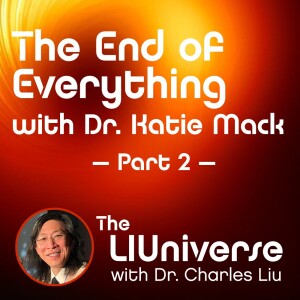
Saturday Sep 07, 2024
Saturday Sep 07, 2024
How did the universe evolve, and more importantly, how might it end? To find out, Dr. Charles Liu and co-host Allen Liu welcome theoretical cosmologist and astrophysicist, Dr. Katie Mack, author of the recently published book, “The End of Everything (Astrophysically Speaking).” In Part 2, we look at dark matter, Gravitational Memory Effect, and more. (You can listen to Part 1 here.)
We dive right in with a question from David: “I was wondering if any physicists have looked into the idea that the “empty” space in an atom is actually “filled” with dark matter. What experiments could be done to prove or disprove this hypothesis?”
In order to answer David, first Katie explains the science supporting the idea that dark matter exists, including gravitational lensing and other evidence. The fact that there are indications of dark matter in areas where there is sparse regular matter suggests that dark matter is an entirely different kind of particle. Katie describes many of the ways that that dark matter is unrelated to the empty space in atoms, including the fact that dark matter has no real interaction with atoms at all.
Chuck asks whether the amount of dark matter still holds the key to how the universe evolves as he was taught or have new understandings made it entirely irrelevant? Katie explains that dark energy has replaced dark matter in importance, and that’s what’s making the universe expand faster. But we really don’t know what it is, or what it’s doing, or even if it will remain constant.
Our next question comes from Aileen Balderas: “I recently read about something called the Gravitational Memory Effect. This talks about how space remembers certain things. Gravitational wave signals have the power to make it so that the universe remembers what happens to it. How can scientists say that the universe is able to remember things?”
Katie unpacks this fascinating phenomenon which she only learned about five years ago. It turns out that, as Chuck puts it, “The universe has memory the way that memory foam has memory, not like the way elephants have memory.”
Chuck asks Katie about flying planes, which she learned to do in late 2020 during the pandemic, after her book came out. Talk about a lockdown hobby! Katie shares why she loves flying so much, and what she gets out of it. And while she doesn’t own her own plane, she has a share in a single engine airplane with 4 other people.
Chuck also asks the inevitable question: Star Trek or Star Wars? Katie’s answer: Star Trek!
We end the show with Katie describing what she’s doing at The Perimeter Institute, an independent research institute that’s dedicated to stretch the boundaries of our understanding of physics in areas like cosmology, particle physics, quantum information and various areas of theoretical physics. Katie’s been working with them to create some short videos. Check out Perimeter Institute for Theoretical Physics on YouTube to watch "Quantum Physics 101" and "Cosmology 101."
If you’d like to know more about Dr. Kathryn Mack and her work, check out her website, https://www.astrokatie.com/ where you can also sign up for her newsletter, “Watch this Spacetime.” You can also find her on Bluesky at astrokatie.com, Instagram and TikTok at @astrokatiemack, and Twitter (X), YouTube, and Facebook at @astrokatie.
You can also find Katie on John Green’s “Crash Course Pods: The Universe” on Complexly, YouTube, Spotify, Simplecast and more.
We hope you enjoy this episode of The LIUniverse, and, if you do, please support us on Patreon.
Credits for Images Used in this Episode:
Galaxy group "Stephan's Quintet" seen by NASA's James Webb Space Telescope – NASA, ESA, CSA, and STScI
NGC 4826, otherwise known as M64— a spiral galaxy. – NASA / Hubble Heritage Team
Hubble image showing light distortions from the collective gravity of dark matter. – NASA, ESA, and J. Lotz and the HFF Team (STScI)
The expansion of the universe over time. – NASA
The End of Everything (Astrophysically Speaking) – Scribner
Dr. Katie Mack in the cockpit of her plane – Image via Katie Mack’s Instagram
#TheLIUniverse #CharlesLiu #AllenLiu #SciencePodcast #AstronomyPodcast #DarkMatter #DarkEnergy #UniversalExpansion #BlackHoles #EarlyUniverse #Spacetime #Physics #Astrophysics #Cosmology #GravitationalMemoryEffect #GravitationalWaves
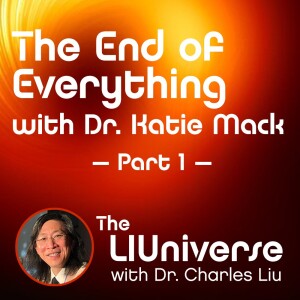
Saturday Aug 24, 2024
Saturday Aug 24, 2024
How did the universe evolve, and more importantly, how might it end? To find out, Dr. Charles Liu and co-host Allen Liu welcome theoretical cosmologist and astrophysicist, Dr. Katie Mack, author of the recently published book, “The End of Everything (Astrophysically Speaking).” You’re going to need your thinking caps for this episode, because the trio get into some pretty intense and complex concepts in physics and astrophysics.
We start off this episode hearing why Katie, who grew up under the starless pink skies in LA, embarked on her journey to explore the very beginnings of existence itself. It turns out, it wasn’t the constellations or “pretty space pictures” that drew her to astrophysics, but the fact that all of the really cool, mindbending questions and extreme physics were related to stuff that happens in space like black holes and spacetime and “The Big Bang.”
For the day’s joyfully cool cosmic thing. Chuck, who studies Observational Galaxy Evolution, brings up a paper recently published in the Astrophysical Journal by Anna de Graaff et al, about the discovery, using the James Webb Space telescope, of a group of 13-billion-year-old dwarf galaxies with an unusually large amount of dark matter inside them compared to modern day galaxies. The researchers then used the Illustris cosmological simulation of galaxy formation to evolve those galaxies and found that they would end up with a percentage of dark matter that is consistent with dwarf galaxies today.
Katie talks about the value of simulations in the study of the galaxies and the early universe, especially as the simulations get better at exploring more physics, like Illustris does. The kinds of simulations she works with, though, are more simple models designed to capture the essential physics of galactic evolution.
She’s currently studying the possibility of dark matter annihilation in the early universe and what that would mean in terms of interacting with gas and energy as galaxies evolve. (At least, we think that’s what Katie’s talking about!)
Then it’s time for our first cosmological question for Katie. Ellis asks, “What’s your opinion on Block Universe theory?” Katie explains how the Block Universe theory attempts to model the past, present and future of spacetime, and how every point in space and time exists at the same time. (Again, we think that’s what she’s talking about!)
You’ll hear about physics equations that look the same forward and backward in time, the Second Law of Thermodynamics, relativity, causality, predetermination, the limits of observation, and the meaning of time itself.
Next, Chuck asks Katie about her book, “The End of Everything” and how she thinks the universe might end. The two discuss string theory, bouncing membranes, the ekpyrotic model of the universe, and other cyclical cosmological models. Katie shares how people often respond to her book from a theological perspective, including the idea of cyclical universes in religion.
Finally, this episode addresses the confluence of science, philosophy and faith, looking at life and death, religion and the divine, personal beliefs and the need many people have to find meaning in existence and possibly even objective truth.
Like we said, thinking caps! And that’s just Part 1. Join us in two weeks for the conclusion to our interview with Katie.
If you’d like to know more about Dr. Kathryn Mack and her work, check out her website, https://www.astrokatie.com/. You can also find her on Instagram and TikTok @astrokatiemack, and Twitter (X), YouTube, and Facebook @astrokatie.
We hope you enjoy this episode of The LIUniverse, and, if you do, please support us on Patreon.
Credits for Images Used in this Episode:
TNG simulation (lines and shade) versus observations (symbols) – de Graaff et al. 2024
Observers moving through a block universe – Jonathan Schooler/UCSB
Model of two branes in extradimensional space that give rise to a cyclic universe. – Princeton University
"The End of Everything (Astrophysically Speaking)" – Scribner
#TheLIUniverse #CharlesLiu #AllenLiu #SciencePodcast #AstronomyPodcast #ObservationalGalaxyEvolution #DwarfGalaxies #DarkMatter #Illustris #CosmologicalSimulation #GalaxyFormation #GalacticEvolution #Galaxies #BlackHoles #EarlyUniverse #DarkMatterAnnihilation #BlockUniverseTheory #Spacetime #SecondLawOfThermodynamics #Physics #Astrophysics #StringTheory #BouncingMembranes #EkpyroticModelOfTheUniverse #CyclicalModels #Cosmology #Theology #Philosophy

The LIUniverse with Dr. Charles Liu
Join us for a half-hour dose of cosmic conversation with scientists, educators & students on the cosmos, scientific frontiers, scifi, more. And if you love science, please support us on Patreon.
Host: Dr. Charles Liu, Astronomer
Co-host: Allen Liu, Mathematician





